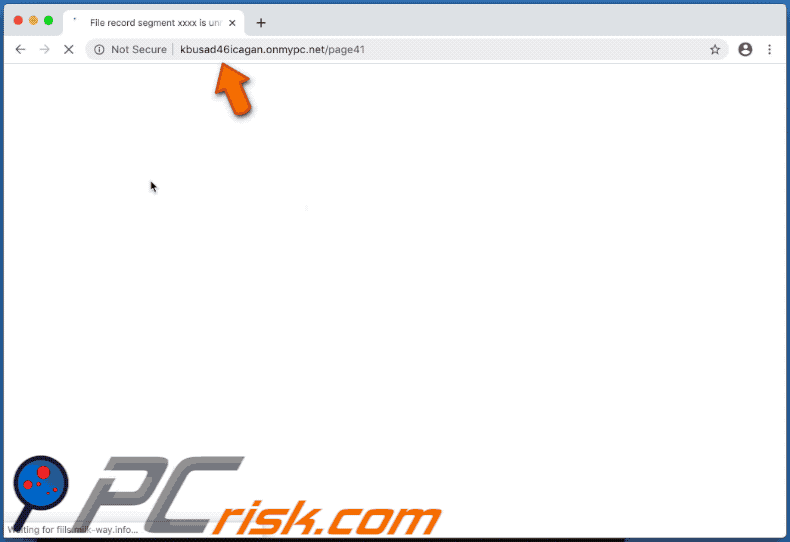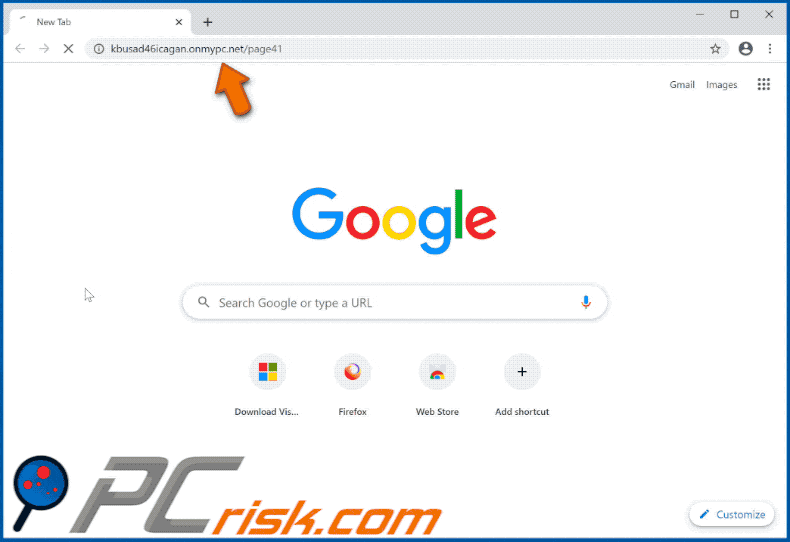Get free scan and check if your device is infected.
Remove it nowTo use full-featured product, you have to purchase a license for Combo Cleaner. Seven days free trial available. Combo Cleaner is owned and operated by RCS LT, the parent company of PCRisk.com.
What is onmypc[.]net?
onmypc[.]net is designed to load various untrustworthy websites. This, and other similar sites, load adult websites, scam websites, pages that are designed to trick visitors into downloading potentially unwanted applications (PUAs) including browser hijackers, adware, and so on.
Typically, people do not open the addresses of sites such as onmypc[.]net intentionally. In most cases, they are opened through deceptive advertisements, untrustworthy web pages and/or by PUAs that are installed on browsers or operating systems.
![onmypc[.]net scam](/images/stories/screenshots202002/onmypc-net-scam-homepage.jpg)
At the time of research, onmypc[.]net loaded an adult website and the "You Are Today's Lucky Visitor" scam web page. This second site attempts to trick visitors into believing that they have the chance win a prize by taking part in a survey.
These web pages are designed by scammers to extort various personal information from people (such as credit card details), which could be misused to generate revenue in various ways. Websites of this type should never be trusted. The scammers behind them can misuse details provided to steal identities, make fraudulent purchases, transactions, etc.
Note that onmypc[.]net might load web pages advertising various PUAs. For example, browser hijackers or adware-type apps. Typically, browser hijackers promote the addresses of fake search engines by changing browser settings. Most also gather browsing data including IP addresses, geolocations, entered search queries, addresses of visited pages, and so on).
Some PUAs record personal, sensitive information as well. Adware-type apps feed users with intrusive advertisements that redirect people who click them to various untrusted web pages. The ads can execute scripts to download or install unwanted software. Adware can also track and record information.
Furthermore, onmypc[.]net can load pages used to trick visitors into installing malicious software including Trojans, ransomware, and other high-risk malware. Installed Trojans cause installation of malware by opening 'backdoors' for other programs of this kind to infiltrate.
Ransomware encrypts files so that victims are unable to recover them without specific tools that can only be purchased from the cyber criminals responsible. In summary, never trust any web pages loaded/opened through onmypc[.]net.
| Name | onmypc.net pop-up |
| Threat Type | Phishing, Scam, Mac malware, Mac virus. |
| Detection Names | Spam404 (Malicious), Full List (VirusTotal) |
| Serving IP Address | 209.208.4.62 |
| Symptoms | Your Mac becomes slower than normal, you see unwanted pop-up ads, you are redirected to dubious websites. |
| Distribution methods | Deceptive pop-up ads, free software installers (bundling), fake Flash Player installers, torrent file downloads. |
| Damage | Internet browser tracking (potential privacy issues), display of unwanted ads, redirects to dubious websites, loss of private information. |
| Malware Removal (Windows) |
To eliminate possible malware infections, scan your computer with legitimate antivirus software. Our security researchers recommend using Combo Cleaner. Download Combo CleanerTo use full-featured product, you have to purchase a license for Combo Cleaner. 7 days free trial available. Combo Cleaner is owned and operated by RCS LT, the parent company of PCRisk.com. |
People do not often visit URLs such as onmypc[.]net intentionally. Typically, they are opened by PUAs already installed on the browser and/or operating system. These apps are classified as PUAs, since people usually download and install them inadvertently.
They force browsers to open dubious web pages, gather browsing-related (and other) information and display intrusive ads.
How did potentially unwanted applications install on my computer?
Typically, PUAs are downloaded/installed together with other (usually free) programs. I.e., when they are included into their download or/and installation set-ups. In most cases, information about additionally-included apps (PUAs) is hidden in "Custom", "Advanced" and other similar settings.
People who download and install programs without checking and changing these settings tend to inadvertently allow PUAs to infiltrate. This PUA distribution method is known as "bundling". Clicking deceptive ads that execute certain scripts can also down and install PUAs.
How to avoid installation of potentially unwanted applications
Files and programs should be downloaded only from official websites. Other channels, tools such as third party downloaders, installers, Peer-to-Peer networks (torrent clients, eMule), dubious websites, etc., are often used to distribute PUAs - in some cases, even malicious programs.
Check all download/installation set-ups, which contain settings such as "Custom" and "Advanced", and dismiss offers to download/install PUAs before completing the process.
Do not click advertisements that are displayed on dubious websites (e.g., those pages relating to pornography, gambling, adult dating, etc.) - they can open untrusted, potentially malicious websites or download/install unwanted apps. Remove any unwanted, suspicious apps (extensions, plug-ins and add-ons) installed on the browser.
The same should be applied to software of this kind that is installed on the operating system. If your computer is already infected with PUAs, we recommend running a scan with Combo Cleaner Antivirus for Windows to automatically eliminate them.
onmypc[.]net loads adult website (GIF):

onmypc[.]net loads "You Are Today's Lucky Visitor" (GIF):

Instant automatic malware removal:
Manual threat removal might be a lengthy and complicated process that requires advanced IT skills. Combo Cleaner is a professional automatic malware removal tool that is recommended to get rid of malware. Download it by clicking the button below:
DOWNLOAD Combo CleanerBy downloading any software listed on this website you agree to our Privacy Policy and Terms of Use. To use full-featured product, you have to purchase a license for Combo Cleaner. 7 days free trial available. Combo Cleaner is owned and operated by RCS LT, the parent company of PCRisk.com.
Quick menu:
- What is onmypc.net pop-up?
- How to identify a pop-up scam?
- How do pop-up scams work?
- How to remove fake pop-ups?
- How to prevent fake pop-ups?
- What to do if you fell for a pop-up scam?
How to identify a pop-up scam?
Pop-up windows with various fake messages are a common type of lures cybercriminals use. They collect sensitive personal data, trick Internet users into calling fake tech support numbers, subscribe to useless online services, invest in shady cryptocurrency schemes, etc.
While in the majority of cases these pop-ups don't infect users' devices with malware, they can cause direct monetary loss or could result in identity theft.
Cybercriminals strive to create their rogue pop-up windows to look trustworthy, however, scams typically have the following characteristics:
- Spelling mistakes and non-professional images - Closely inspect the information displayed in a pop-up. Spelling mistakes and unprofessional images could be a sign of a scam.
- Sense of urgency - Countdown timer with a couple of minutes on it, asking you to enter your personal information or subscribe to some online service.
- Statements that you won something - If you haven't participated in a lottery, online competition, etc., and you see a pop-up window stating that you won.
- Computer or mobile device scan - A pop-up window that scans your device and informs of detected issues - is undoubtedly a scam; webpages cannot perform such actions.
- Exclusivity - Pop-up windows stating that only you are given secret access to a financial scheme that can quickly make you rich.
Example of a pop-up scam:

How do pop-up scams work?
Cybercriminals and deceptive marketers usually use various advertising networks, search engine poisoning techniques, and shady websites to generate traffic to their pop-ups. Users land on their online lures after clicking on fake download buttons, using a torrent website, or simply clicking on an Internet search engine result.
Based on users' location and device information, they are presented with a scam pop-up. Lures presented in such pop-ups range from get-rich-quick schemes to fake virus scans.
How to remove fake pop-ups?
In most cases, pop-up scams do not infect users' devices with malware. If you encountered a scam pop-up, simply closing it should be enough. In some cases scam, pop-ups may be hard to close; in such cases - close your Internet browser and restart it.
In extremely rare cases, you might need to reset your Internet browser. For this, use our instructions explaining how to reset Internet browser settings.
How to prevent fake pop-ups?
To prevent seeing pop-up scams, you should visit only reputable websites. Torrent, Crack, free online movie streaming, YouTube video download, and other websites of similar reputation commonly redirect Internet users to pop-up scams.
To minimize the risk of encountering pop-up scams, you should keep your Internet browsers up-to-date and use reputable anti-malware application. For this purpose, we recommend Combo Cleaner Antivirus for Windows.
What to do if you fell for a pop-up scam?
This depends on the type of scam that you fell for. Most commonly, pop-up scams try to trick users into sending money, giving away personal information, or giving access to one's device.
- If you sent money to scammers: You should contact your financial institution and explain that you were scammed. If informed promptly, there's a chance to get your money back.
- If you gave away your personal information: You should change your passwords and enable two-factor authentication in all online services that you use. Visit Federal Trade Commission to report identity theft and get personalized recovery steps.
- If you let scammers connect to your device: You should scan your computer with reputable anti-malware (we recommend Combo Cleaner Antivirus for Windows) - cyber criminals could have planted trojans, keyloggers, and other malware, don't use your computer until removing possible threats.
- Help other Internet users: report Internet scams to Federal Trade Commission.
Share:

Tomas Meskauskas
Expert security researcher, professional malware analyst
I am passionate about computer security and technology. I have an experience of over 10 years working in various companies related to computer technical issue solving and Internet security. I have been working as an author and editor for pcrisk.com since 2010. Follow me on Twitter and LinkedIn to stay informed about the latest online security threats.
PCrisk security portal is brought by a company RCS LT.
Joined forces of security researchers help educate computer users about the latest online security threats. More information about the company RCS LT.
Our malware removal guides are free. However, if you want to support us you can send us a donation.
DonatePCrisk security portal is brought by a company RCS LT.
Joined forces of security researchers help educate computer users about the latest online security threats. More information about the company RCS LT.
Our malware removal guides are free. However, if you want to support us you can send us a donation.
Donate
▼ Show Discussion